Common menu bar links
Archived - Restoring Fiscal Balance for a Stronger Federation
- Note: to read the PDF version you need Adobe Acrobat Reader on your system. If the Adobe download site is not accessible to you, you can download Acrobat Reader from an accessible page at: http://www.adobe.com/products/acrobat/alternate.html. If you choose not to use Acrobat Reader you can have the PDF file converted to HTML or ASCII text by using one of the conversion services offered by Adobe at http://www.adobe.com/products/acrobat/access_onlinetools.html.
- To view the RTF version, use the document conversion features available in most modern word processing software, or use a file viewer capable of reading RTF.
|
"There's been a lot of talk about fiscal balance...But what is it really all about? It's about better roads and renewed public transit. Better health care. Better-equipped universities. Cleaner oceans, rivers, lakes and air. Training to help Canadians get the skills they need. It's about building a better future for our country. And that means getting adequate funding to provincial and territorial governments.Through this budget, we are delivering an historic plan worth over $39 billion in additional funding to restore fiscal balance in Canada."
Minister Flaherty |
Canada's New Government is building a stronger federation in which all governments come together to help Canadians realize their potential. This stronger federation is built on a vision of open federalism, with more respectful relations with taxpayers and governments, and with greater collaboration to deliver results for Canadians.
Budget 2006 took a major step to resolving fiscal balance by setting out a principles-based plan and taking immediate action.
Budget 2007 follows through on every commitment of the plan and goes further.
- It restores fiscal balance with provinces and territories by putting transfers on a long-term principles-based footing.
- It takes another step towards restoring fiscal balance with Canadian taxpayers through major tax reductions and the Tax Back Guarantee.
- It makes governments more accountable to Canadians by clarifying roles and responsibilities.
- It strengthens the economic union based on the plan set out in Advantage Canada.
With fiscal balance restored, governments can focus on what matters to Canadians: strengthening our health care system; achieving excellence and accessibility in our post-secondary education system; ensuring that we have skilled workers to meet the needs of our economy and compete with the best in the world; helping make training available to those who need it; making progress on environmental challenges; creating better roads and transit systems; and building a stronger economic union.
Restoring Fiscal Balance With Provinces and Territories
Budget 2007 restores fiscal balance with provinces, territories and municipalities by providing long-term, equitable and predictable funding for shared priorities. It provides $39 billion in additional funding over seven years.
- Renewed and strengthened Equalization, providing $1.5 billion more in 2007-08 than last year, will ensure fair treatment of Canadians in all parts of the country and enable provinces to provide their residents with comparable levels of services at comparable levels of taxation. The new program will provide an estimated $1.9 billion more over two years than the previous system.
- Renewed and strengthened Territorial Formula Financing (TFF) that reflects the unique circumstances and high costs in the north, providing $115 million more in 2007-08. This means an estimated $162 million more over two years than the previous system.
- Full implementation of the 10-Year Plan to Strengthen Health Care, providing $1.2 billion more to provinces and territories in 2007-08.
- A new approach to support post-secondary education, children and social programs through a strengthened Canada Social Transfer (CST). The CST will be legislated to 2013-14, with an automatic 3-per-cent escalator, and be made more transparent. It includes $800 million more for post-secondary education and $250 million for child care spaces, beginning in 2008-09. This means over $16 billion in new funding over seven years.
- Ensuring equal support for all Canadians through an investment of almost $700 million in equal per capita support under the CST in 2007-08 and legislation of equal per capita cash support under the Canada Health Transfer when it is renewed.
- $500 million annually starting in 2008-09 for a new approach to labour market training to help ensure that Canadians who need skills training will receive it. This provides a total of $3 billion more for training by 2013-14.
- Ensuring long-term, predictable funding for infrastructure, building on Budget 2006 investments. This new long-term plan for infrastructure will mean federal support will grow from $3.2 billion per year when this Government took office, to nearly $5.7 billion per year by 2013-14. This means more than $16 billion in new funding over the next seven years.
Restoring Fiscal Balance With Canadian Taxpayers
Canadians pay too much in taxes. The Government is working to restore fiscal balance with Canadians, and has and will continue to reduce taxes so that it only raises the revenues that it needs to fulfill its responsibilities. Budget 2007 delivers:
- $9.7 billion in tax relief, leaving more money in the pockets of Canadians and providing businesses with a more competitive tax environment.
- A new approach to allocating surpluses through a Tax Back Guarantee to ensure that Canadians benefit directly from federal debt reduction through lower personal income taxes. Already, the Tax Back Guarantee will reduce personal income taxes by $2.4 billion in the next two years, representing one-quarter of the $9.7 billion in tax relief that this budget provides.
- Disciplined spending by limiting the growth in program spending on average to below the rate of growth of the economy and implementing a new Expenditure Management System.
Making Governments More Accountable by Clarifying Roles and Responsibilities
Budget 2007 enhances the accountability of governments toward Canadians by clarifying roles and responsibilities-and lets each order of government focus on what it does best through:
- Focused spending in areas of core federal responsibility.
- Limiting the federal spending power.
- Greater transparency in federal budget planning.
- Greater transparency in the areas supported by the CST, through earmarking of support for post-secondary education, children and other social programs.
- A new approach to labour market training that recognizes that provinces and territories are best placed to deliver and design labour market training programs.
Working Together for a Stronger Economic Union
With fiscal balance restored, governments can now focus on building a stronger and more prosperous Canada. Advantage Canada presented a comprehensive plan aimed at fostering a stronger economic union. Budget 2007 delivers a number of measures to further strengthen Canada's economic union, including:
- Financial incentives for provinces to eliminate or accelerate the elimination of their capital taxes.
- Enhanced labour market training programs and strengthened programs for immigrants to make sure employers have access to the people they need to increase our prosperity.
- A Working Income Tax Benefit to remove barriers to work for low- and modest-income Canadians.
- Launching a plan to create a Canadian advantage in global capital markets.
A Better Future for Canada
Budget 2007 fulfills the Government's commitment to restore fiscal balance. It is a comprehensive, long-term plan that responds to concerns raised by Canadians, and by provinces and territories. Cash funding to provinces and territories, which stood at $43 billion when this Government took office in 2006, will be at least $18 billion higher in 2013-14.
The plan is sustainable, affordable and fair, and recognizes that all governments are answerable to Canadians-and must deliver results.
Moving forward, the Government will maintain fiscal balance by respecting the principles it has established.
It will continue to reduce the tax burden on Canadians including through the Tax Back Guarantee, and be disciplined in its spending.
It will provide ongoing support to provinces and territories, and work with them collaboratively to deliver results for Canadians.
It will continue to focus on what it does best and only what the Government of Canada can do for all Canadians.
It will work in collaboration with provinces, territories and stakeholders to build a stronger economic union for a more prosperous Canada.
Overview
Canada's New Government is building a stronger federation in which all governments come together to help Canadians realize their potential. This stronger federation is built on a vision of open federalism and respectful relations, where governments collaborate effectively to deliver results for Canadians.
For many years, governments have worked together to create a network of quality services-a public health care system that reflects Canada's shared values and national identity, a quality post-secondary education system with one of the highest graduation rates in the world, social programs that we are proud of, and a modern infrastructure system that spans our vast country.
Since the mid-1990s, however, there have been concerns about fiscal balance in Canada-and the tension that ensued among governments undermined their ability to work effectively together.
Canadians have grown tired of the intergovernmental bickering over fiscal balance issues, and want them resolved.
Budget 2006 began to act on these concerns by acknowledging the need to restore fiscal balance in the federation through a principles-based plan and by fostering a new spirit of open federalism.
Budget 2007 restores fiscal balance in Canada. This will help to bring an end to intergovernmental disputes and allow governments to focus on the things that matter to Canadians: to strengthen our health care system; to achieve excellence and accessibility in our post-secondary education system; to ensure that we have skilled workers to meet the needs of our economy and compete with the best in the world; to help make training available to those who need it; to make progress on environmental challenges; to create better roads and transit systems; and to build a stronger economic union.
Restoring fiscal balance is a historic achievement. By restoring fiscal balance, Canada's New Government is laying the foundations for a stronger federation. A restored fiscal balance will ensure provinces and territories have both the means and clarity of purpose to develop and provide programs and services that serve Canadians well. All Canadians will benefit from the provinces and territories being well equipped to invest in health care, post-secondary education, modern infrastructure and social programs.
With fiscal balance restored, governments can now go forward and focus on building a stronger and more prosperous Canada. Advantage Canada presented a comprehensive plan aimed at fostering a stronger economic union. In the coming months, the Government will be working on this plan, in collaboration with provinces, territories and stakeholders, to build a better future for Canada.
Budget 2006: A Plan to Restore Fiscal Balance
Identifying Concerns and Establishing Principles
In Budget 2006, the Government presented its approach to restore fiscal balance in Restoring Fiscal Balance in Canada. It identified a number of issues that have created strains in the federation:
- Concerns that federal budgeting had not been sufficiently transparent, in particular that the federal government, in the past, had generated large unanticipated surpluses that had been used to spend in areas of provincial-territorial responsibility.
- Concerns about blurred accountability to taxpayers and reduced clarity with respect to roles and responsibilities of each order of government.
- Concerns that some transfers-Equalization, Territorial Formula Financing and funding for post-secondary education, training and infrastructure-needed to be put on a principles-based, predictable long-term track.
- Finally, the need for governments, separately and working together, to build a more competitive and efficient economic union.
- Accountability through clarity of roles and responsibilities.
- Fiscal responsibility and budget transparency.
- Predictable, long-term fiscal arrangements.
- A competitive and efficient economic union.
- Effective collaborative management of the federation.
Early Action in Budget 2006
Guided by these principles, the Government took immediate action in Budget 2006. It moved to restore fiscal balance with the taxpayers of Canada through $26 billion in tax reductions. It reaffirmed its support for long-term, predictable funding for health care. Budget 2006 also made significant new investments in infrastructure and provided $3.3 billion in funding to provinces and territories for short-term pressures in post-secondary education, affordable housing and public transit.
Budget 2006 introduced measures to enhance federal fiscal responsibility and transparency in budget planning. It brought more clarity to the roles and responsibilities of governments by focusing spending in areas of core federal responsibility such as defence and security.
A Framework to Resolve Fiscal Balance
Budget 2006 committed to follow up with specific measures-following consultations with provinces, territories, academics and other stakeholders-to restore fiscal balance. Specifically, Canada's New Government committed to deliver in Budget 2007:
- A renewed and strengthened Equalization program.
- A renewed and strengthened Territorial Formula Financing program.
- A new approach to long-term funding support for post-secondary education.
- A new approach to long-term funding support for training.
- A new long-term plan for infrastructure.
- A new approach to allocating unplanned federal surpluses.
The Government also committed to move forward on fiscal balance in a principled way by:
- Further clarifying roles and responsibilities by focusing new spending on areas of core federal responsibility and limiting the use of the federal spending power.
- Working, in collaboration with other levels of government, to strengthen the economic union.
In Budget 2006, the Government of Canada committed to consult provinces and territories, parliamentarians, academics and experts, and individual Canadians on its approach to restoring fiscal balance.
The Government of Canada sought the views of individual Canadians through online consultations.
The Minister of Finance met with his provincial/territorial counterparts in Niagara-on-the-Lake in June 2006, and again in Vancouver in December 2006.
The Ministers of Intergovernmental Affairs, Health, Transport, Infrastructure and Communities, and Human Resources and Social Development consulted their provincial and territorial counterparts on issues related to fiscal balance, such as the federal spending power, patient wait times guarantee and the federal role in infrastructure, post-secondary education and training.
A series of consultations was also held with academics and experts on fiscal balance issues.
A summary of what was heard in those consultations has been made available on the Department of Finance website at www.fin.gc.ca.
Budget 2007 Restores Fiscal Balance
Canadians want fiscal balance restored so governments can get on with working together to deliver results. Building on the progress to date, Budget 2007 proposes a comprehensive plan to restore fiscal balance, including further tax reductions. It delivers on each of the specific commitments made in Budget 2006, and goes even further. It does so in a principled way, in a national context, and by respecting existing agreements and commitments. The plan:
- Restores fiscal balance with provinces and territories by putting transfers on a long-term principles-based footing.
- Takes another step towards restoring fiscal balance with Canadian taxpayers through major tax reductions and the Tax Back Guarantee.
- Makes governments more accountable to Canadians by clarifying roles and responsibilities.
- Strengthens the economic union based on the plan set out in Advantage Canada.
Restoring Fiscal Balance With Provinces and Territories
Budget 2007 restores fiscal balance with provinces, territories and municipalities by providing more than $39 billion over seven years in long-term, equitable and predictable funding for shared priorities.
Renewing and Strengthening Equalization
The purpose of Equalization is to ensure that all Canadians, wherever they live, have access to reasonably comparable services at reasonably comparable levels of taxation. The principle of equalization has been enshrined in the Constitution of Canada since 1982, and reflects Canadians' strong commitment to fairness.
In practical terms, this means that, for example, the Government of Prince Edward Island receives close to $2,200 per person in Equalization to recognize that its revenue-raising capacity-the amount it could raise if it levied average tax rates-is $2,200 less than the national average. These payments are critical to Prince Edward Island, as they represent close to 25 per cent of the province's total revenues.
Other provinces with less than average revenue-raising capacity also receive Equalization payments to ensure that their revenues are brought up to the point where they can provide comparable programs and services. When a province has a revenue-raising capacity above the national average-for example, Alberta-it does not receive Equalization payments.
- The Equalization program has existed since 1957, and the principle has been enshrined in the Constitution of Canada since 1982.
- Equalization payments are entirely funded by federal revenue sources. Provinces do not make payments to each other.
- Equalization payments are unconditional. This means that provinces are able to direct these funds to their own priorities.
- Equalization payments are made only to the less prosperous provinces. The lower a province's fiscal capacity, the more per capita it receives.
- Equalization is not a permanent entitlement. As a province's economic fortunes improve, its Equalization payments will decline. Conversely, as a province's economic fortunes decline, its Equalization payments will increase.
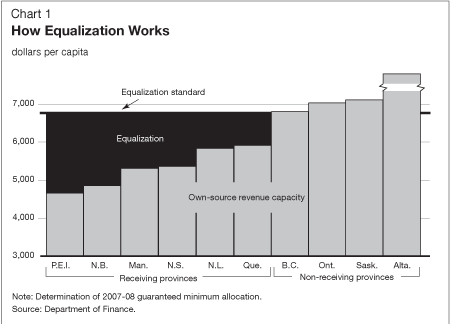
A Review of Equalization
In 2004 and 2005, changes were made to the Equalization program that represented a significant departure from its long-standing operations and principles. In particular, normal formula-based calculations of provincial entitlements were suspended; an interim formula was used to allocate payments; and a new financial "framework" for Equalization was introduced that separated the Equalization standard from the overall measurement of fiscal disparities.
In light of these changes, as well as questions about the treatment of natural resources in the program and the enrichments that were made to the companion arrangements, the Offshore Accords, a review of the Equalization program by the independent Expert Panel on Equalization and Territorial Formula Financing, chaired by former Deputy Provincial Treasurer of Alberta, Al O'Brien, was launched in 2005.
Budget 2006 Committed to Put Equalization Back on Track
When Canada's New Government came to office, it recognized the need to put Equalization back on a sound formula basis. Budget 2006 therefore committed to taking action after consultations were undertaken with Canadians and with provinces, and the Expert Panel's report and other proposals to improve the program were examined.
In establishing a new Equalization program, the Government committed to ensure a treatment of non-renewable resource revenues that encourages economic growth through the development of these resources. It also said it would respect the Offshore Accords, which were signed between the Government of Canada and the Governments of Newfoundland and Labrador and Nova Scotia and designed to support these provinces in dealing with their unique fiscal challenges, particularly their high debt burdens.
Budget 2007 Implements the Recommendations of the Expert Panel on Equalization
Budget 2007 delivers a new Equalization program that is fair to Canadians living in all provinces. It will be formula-driven and principled. It will be simplified to enhance transparency and accountability. It will be stable and predictable. It will meet the commitments related to exclusion of non-renewable resources and respecting the Offshore Accords.
In June 2006, the Government received the final report of the Expert Panel on Equalization, entitled Achieving A National Purpose: Putting Equalization Back on Track (O'Brien report), which proposed a comprehensive, principles-based set of reforms to Canada's Equalization program. Based on a careful review of the report and extensive consultations with Canadians and provincial governments, the Government has concluded that the Expert Panel's recommendations strike a reasonable balance among the divergent views and interests of provinces. They form a solid foundation upon which to renew this program.
Budget 2007 proposes to implement the recommendations of the O'Brien report, which include:
- A higher Equalization standard reflecting the fiscal capacity of all 10 provinces (the "10-province standard"). This standard ensures that Equalization brings the revenue-raising capacity of less prosperous provinces up to the national average.
- A new approach to the treatment of natural resource revenues under which resource-producing provinces would retain additional fiscal benefits from their resources through a 50-per-cent exclusion of those revenues from the calculation of Equalization payments.
- A fiscal capacity cap to ensure that Equalization payments do not unfairly bring a receiving province's overall fiscal capacity to a level higher than that of any non-receiving province.
- An improved measurement of fiscal capacity that adopts a market-value base for residential property taxes and excludes user fee revenues; a simplified measure of capacity that reduces the number of tax bases from 33 to 5; and a simplified estimate and payment system to increase the predictability and stability of payments.
A Strengthened Equalization Program Allows Comparable Treatment for All Canadians
The new Equalization program ensures that Equalization-receiving provinces have the necessary resources to provide reasonably comparable programs and services as those provided by provinces with higher own-source revenues. The strengthened program also allows the Government to provide comparable treatment to Canadians in other major federal transfers-a principle supported in Advantage Canada and the O'Brien report.
Accordingly, Budget 2007 proposes to legislate an equal per capita cash allocation for both major transfers, the Canada Social Transfer (CST) and the Canada Health Transfer (CHT), as they are renewed. By doing so, Budget 2007 will eliminate what the O'Brien report referred to as "back door" equalization in these programs and make the federal contribution more transparent.
- The new equal per capita cash allocation will become effective for the CST in 2007-08, as its legislation is being renewed and strengthened in this budget.
- To respect the agreement on the 10-Year Plan to Strengthen Health Care-which was signed by all First Ministers-the move to an equal per capita cash allocation for the CHT will be legislated to take effect in 2014-15, when the current legislation expires.
Taken together, these measures-the introduction of a strengthened Equalization program combined with a fiscal capacity cap and an equal per capita cash allocation in other major federal transfers-ensure that the new transfer system is more generous than before and that fundamental fairness is brought back to fiscal arrangements.
Fulfilling the Commitment to Exclude Non-Renewable Resource Revenues
The core elements of the O'Brien report-a 10-province standard with a 50-per-cent exclusion rate for natural resource revenues and a fiscal capacity cap-provide a higher Equalization standard than either the previous system or one that fully excludes non-renewable resources. As a result, the O'Brien formula provides both a substantial incentive to provinces to develop their natural resources and higher payments to most provinces than one that fully excludes non-renewable resources.
Consistent with the Government's commitment, Budget 2007 proposes to ensure that, under the new Equalization formula, all provinces will receive the greater of the Equalization entitlements under the formula based on a 50-per-cent exclusion rate, and the amounts they would receive under the same formula based on full exclusion of all natural resource revenues. This will further improve incentives for resource-producing provinces and provide them additional protection against future declines in resource prices and production levels, and fulfill the Government's commitment to fully exclude non-renewable natural resources revenues from the calculation of Equalization-without lowering the payments to any province.
Fulfilling the Commitment to Respect the Offshore Accords
To respect the Offshore Accords, Nova Scotia and Newfoundland and Labrador may continue to operate under the previous Equalization system until their existing offshore agreements expire. This fulfills and builds upon the Government's commitment to respect the Offshore Accords and ensures that these provinces will continue to receive the full benefit that they are entitled to under the previous system. These provinces can permanently opt into the new Equalization system at any point in the future.
Ensuring a Smooth Transition
In moving to this new Equalization program, the Government recognizes the importance of ensuring a smooth transition given the fundamental nature of the changes being proposed in this budget. That is why, in January 2007, the Government provided provinces with estimates of their 2007-08 payments based on the previous system and a guarantee that, under the renewed Equalization program, provinces would not receive less than these amounts in 2007-08. This has allowed provinces to plan their respective budgets with certainty for the coming fiscal year, knowing the minimum amount that they would receive.
Building on this commitment to ensure a smooth transition and provide certainty in budget planning, Budget 2007 will also ensure that no province or territory will receive lower cash transfers under the CST or CHT relative to what they would have received in 2007-08 prior to the implementation of the new Equalization system and an equal per capita cash allocation. The provision of such protection will amount to an estimated $282 million over five years. The Government also commits to providing similar protection when the CHT allocation is moved to an equal per capita cash basis in 2014-15.
Budget 2007 also proposes transition measures to ensure a smooth implementation of the proposed residential property tax base. Of all the changes to the measurement of fiscal capacity, the single largest impact stems from the move to a new residential property tax base based on market value. Nowhere is this more important than in British Columbia, which has seen significant increases in its housing prices. Budget 2007 proposes, for a three-year transitional period, to provide additional protection to British Columbia by retaining the existing adjustment factor for residential property tax in the calculation of its Equalization payments. Payments to other provinces will not be affected by the provision of such protection.
More details on the new Equalization program and accompanying transition measures can be found in Annex 4 of The Budget Plan.
New Equalization Program Provides More Than $12.7 billion
For 2007-08, the new Equalization program will provide more than $12.7 billion, $1.5 billion higher than payments made in 2006-07. Over time, the cost of Equalization will fluctuate in relation to fiscal disparities: as disparities widen, the cost of Equalization will rise, and as disparities narrow, the cost of Equalization will fall.
The following table shows the legislated payments for 2006-07, the guaranteed minimum (based on the previous system) provided to provinces to give them certainty in budget planning, and entitlements for 2007-08 under the renewed Equalization program. It assumes that Newfoundland and Labrador and Nova Scotia continue to operate under the previous Equalization system in 2007-08.
| Table 1 A New Equalization Program Provides Significant Benefits to Equalization-Receiving Provinces (millions of dollars) |
|||||||||
|
|
N.L.1 |
P.E.I. |
N.S.1 |
N.B. |
Que. |
Man. |
Sask. |
B.C. |
Total |
|---|---|---|---|---|---|---|---|---|---|
|
2006-07 legislated payments |
632 |
291 |
1,386 |
1,451 |
5,539 |
1,709 |
13 |
260 |
11,282 |
|
Offshore offsets |
329 |
57 |
386 |
||||||
|
2007-08 guaranteed minimum allocation |
477 |
291 |
1,308 |
1,435 |
6,462 |
1,703 |
- |
- |
11,676 |
|
Offshore offsets |
494 |
130 |
624 |
||||||
|
2007-08 renewed Equalization |
477 |
294 |
1,308 |
1,477 |
7,160 |
1,826 |
226 |
- |
12,768 |
|
Offshore offsets |
494 |
130 |
624 |
||||||
|
Change From Guaranteed Minimum Allocation |
|||||||||
|
millions of dollars |
- |
3 |
- |
42 |
698 |
123 |
226 |
- |
1,092 |
|
dollars per capita |
- |
22 |
- |
56 |
91 |
104 |
230 |
- |
|
|
Note: Totals may not add due to rounding. |
|||||||||
Renewing and Strengthening Territorial Formula Financing
The situation in Canada's three territories is vastly different from the challenges faced by provinces: the majority of communities are small and isolated; population growth tends to outpace that in the rest of Canada; and costs, including the cost of providing public services, are very high. Territorial Formula Financing (TFF) is the federal program that recognizes these unique circumstances and provides territorial governments with the resources they need to deliver services comparable to those that Canadians enjoy in the rest of Canada.
A well-funded and well-functioning TFF program is critical for essential public services in the north, such as hospitals, schools, infrastructure and social services, since the TFF grant makes up almost two-thirds of government revenues in the Yukon and Northwest Territories, and more than three-quarters of Nunavut's revenues.
In 2004, changes were made to the long-standing operation of TFF similar in nature to those made to the Equalization program. In particular, normal formula-based calculations of territorial payments were suspended; an interim formula was used to allocate payments; and a new financial "framework" for TFF was introduced that separated the total size of TFF from the overall measurement of need.
The Expert Panel on Equalization and Territorial Formula Financing was asked, among other things, to provide advice on the allocation of TFF among the three territories, ways of making TFF payments more stable and predictable, and ways of measuring the costs of providing services in the territories.
In Budget 2006, the Government committed to return TFF to a principles-based formula after reviewing the report of the Expert Panel, as well as other recommendations to strengthen TFF. Budget 2007 delivers on that commitment.
Budget 2007 Implements the Recommendations of the Expert Panel on TFF
Canada's New Government reviewed the report of the Expert Panel on TFF, entitled Achieving a National Purpose: Improving Territorial Formula Financing and Strengthening Canada's Territories (O'Brien report), and undertook extensive consultations.
Budget 2007 implements the O'Brien report's recommendations, which were endorsed by all three territories. The proposed reforms return TFF to a formula-based approach that respects the principles of fairness and predictability and reflects the Government's commitments to the continued development of the north. Consistent with the O'Brien report's recommendations, the main features of the new TFF are:
- A formula-driven approach providing three gap-filling grants to recognize the different circumstances in each of the three territories.
- A simplified approach to the measurement of territorial revenues in the formula.
- Improved incentives for the territories to increase their own revenues and develop their economies.
- A simplified estimate and payment system to increase predictability.
Under the new TFF, total payments will amount to $2.2 billion in 2007-08, $115 million higher than in 2006-07. The following table shows the legislated payments for 2006-07, the guaranteed minimum (based on the previous system) provided to territories to give them certainty in budget planning, and entitlements for 2007-08 under the renewed TFF program.
| Table 2 A New TFF Program Provides Significant Benefits to the Three Territories (millions of dollars) |
||||
| Northwest Territories | Yukon | Nunavut | Total | |
|---|---|---|---|---|
| 2006-07 legislated payments | 753 | 514 | 839 | 2,106 |
| 2007-08 guaranteed minimum allocation | 778 | 537 | 865 | 2,180 |
| 2007-08 renewed TFF | 788 | 540 | 893 | 2,221 |
| Change From Guaranteed Minimum Allocation | ||||
| millions of dollars | 10 | 3 | 28 | 41 |
| dollars per capita | 240 | 107 | 888 | |
| Note: In addition, one-time payments of $54.4 million in 2006-07 to the Northwest Territories to compensate for the impact of a large tax refund and $3.5 million in 2007-08 to the Yukon to honour Canada's remaining transitional funding obligations under the Yukon Devolution Transfer Agreement. Totals may not add due to rounding. Source: Department of Finance. |
||||
More details on the new approach can be found in Annex 4 of The Budget Plan.
With the TFF program on a renewed, principles-based footing, the Government will move ahead with negotiations to devolve onshore natural resource management responsibilities and resource revenues to the territories. As recommended by the O'Brien report, the Government will continue to treat natural resource revenues outside of TFF. Consistent with Equalization, 50 per cent of resource revenues will be excluded from the offset calculation against the TFF grant up to an overall cap, providing a net fiscal benefit and an additional incentive to develop natural resources.
While the situation in all three territories is vastly different from the challenges faced by provinces, nowhere is this more evident than in Nunavut. There exist significant disparities between Nunavut and the rest of the country in key areas such as health, education and social well-being. The Government remains committed to improving the situation in our newest territory.
Budget 2006 provided $200 million in funding for affordable housing in Nunavut. In addition to the significant increases associated with the restoration of fiscal balance, and to address what both the Auditor General of Canada and the Government of Nunavut have indicated is a key priority, Budget 2007 will provide an additional $23 million to strengthen financial management practices and systems in Nunavut.
A New Approach for Long-Term Support for Post-Secondary Education and Other Social Priorities
Renewing and Strengthening the Canada Social Transfer
The Canada Social Transfer is the main federal transfer program providing financial support to provinces and territories for post-secondary education and social assistance and social services, including early childhood development and early learning and child care. This support touches the lives of every Canadian, helping our universities and colleges be among the best in the world and supporting provinces and territories in delivering social assistance and social services that reduce poverty and protect vulnerable Canadians. The CST has also included support for an emerging national priority-early childhood development programs and the creation of flexible child care spaces.
In 2006-07, the CST provided $8.5 billion in cash to provinces and territories. The current CST legislation, however, is set to expire at the end of 2007-08. This raised concerns over the predictability and stability of funding flowing to provinces and territories in support of important social programs.
There have also been concerns regarding:
- The accountability and transparency of the CST-Canadians are not informed of how much federal support is being provided to each of the three priority areas that the CST supports (post-secondary education, social assistance and social services, and support for children).
- The fact that the CST does not provide equal cash support to all Canadians.
Budget 2007 proposes to put the CST on a long-term, predictable path, and make it more transparent and fair, by:
- Extending the CST to 2013-14, putting it on the same long-term legislative track as the CHT, as well as the ones proposed for Equalization and TFF.
- Increasing cash payments under the CST through an annual 3-per-cent escalator, starting in 2009-10, to ensure predictable and sustainable increases broadly in line with population growth and inflation.
- Identifying federal transfer support within the CST, based on current provincial and territorial spending patterns and existing child care agreements, for each priority area-post-secondary education, social programs and support for children-to enhance the transparency of federal support for shared priorities.
- Allocating cash support on an equal per capita basis to ensure equal treatment of all provinces and territories, starting in 2007-08. To bring Ontario, Alberta and the Northwest Territories to the same per capita cash support as that of other provinces and territories, while ensuring that no province or territory is unduly affected by this change, total CST cash levels will be increased by $687 million in 2007-08.
Starting in 2007-08, the CST will be earmarked according to provincial-territorial spending patterns. The chart below shows how the CST will increase by about $1 billion in 2007-08 as a result of the increase in base funding of $300 million, as specified in the existing legislation, and a $687-million increase from the move to fairness to adopt the equal per capita cash support. The chart also shows how the CST will be earmarked in 2007-08 and beyond to show the federal contribution for each of the major areas the CST supports, reflecting provincial-territorial spending patterns.
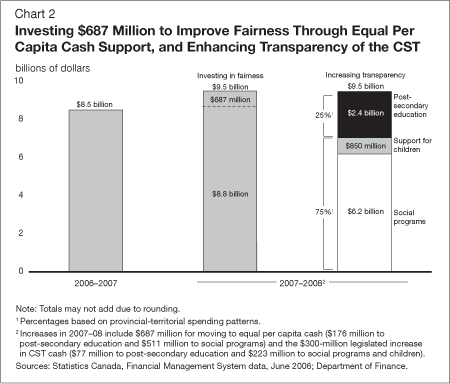
Investing in Post-Secondary Education
Canadians understand that a strong system of higher education is a crucial source of ideas and innovation-creative energy that our economy needs to foster national prosperity. Canadians also know that having a post-secondary education contributes to their own well-being and that of their communities.
Budget 2007 proposes to increase the CST by $800 million per year for provinces and territories with the objective of strengthening the quality and competitiveness of Canada's post-secondary education system.
As elaborated in Chapter 5 of The Budget Plan in the "Knowledge Advantage" section, the increase will take effect in 2008-09, following discussions with provinces and territories on how best to make use of those new investments and ensure appropriate reporting and accountability to Canadians. These discussions will build on the valuable work already undertaken by the Council of the Federation.
CST funding for post-secondary education will be $3.2 billion in 2008-09, an $800-million increase over 2007-08 funding levels. Just as importantly, this support will continue to grow over time as a result of the annual 3-per-cent escalator that is part of the renewed CST.
This increased, earmarked funding meets the Government's commitment to deliver a new approach to funding support for post-secondary education by ensuring long-term, predictable support for provinces and territories, and greater transparency and accountability to Canadians.
The following chart shows the increase in post-secondary education funding under the new approach.
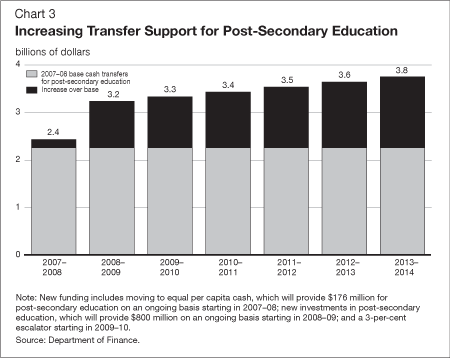
This transfer to provinces and territories is only one way that the federal government provides support for post-secondary education.
The Government of Canada will provide over $8.4 billion in 2007-08 in support of post-secondary education through transfers, direct spending and tax measures:
- $2.4 billion in transfers in 2007-08 to provinces and territories through the CST, rising to $3.2 billion in 2008-09 as a result of Budget 2007 new investments.
- $1.7 billion to help students and families save for their education and deal with tuition and other costs via the tax system, including the tuition, education and textbook tax credits and carry-forward of unused credits. Budget 2007 makes registered education savings plans more responsive to the changing needs of education and encourages parents to save.
- $2 billion to help students deal with the costs of education through grants, scholarships and loan programs, including the Canada Millennium Scholarship Foundation and Canada Student Loans Program (CSLP). This includes Budget 2007 investments of $35 million over two years to bring support for graduate scholarships to its highest level in Canadian history. Budget 2007 launches a review of the CSLP aimed at modernizing and simplifying this important student financial assistance program.
- $2.3 billion to fund research and related activities in post-secondary institutions, including new support announced in this budget for granting councils such as the Natural Sciences and Engineering Research Council of Canada and the Canada Foundation for Innovation.
Supporting the Creation of New Child Care Spaces
In Budget 2006, Canada's New Government introduced the Universal Child Care Plan, a two-pronged strategy to provide support for families with children. In July 2006, parents began receiving support of $100 per month for every child under age 6, to be used for the priorities identified by parents as they determine how best to balance home, work and other commitments. Recognizing that parents often choose to use child care services, the Government also committed to provide $250 million annually to support the creation of up to 25,000 new spaces beginning in 2007-08.
Building on consultations with other governments and service providers, the Government is delivering on this commitment in Budget 2007.
Budget 2007 proposes to provide a 25-per-cent investment tax credit to businesses that create new child care spaces in the workplace to a maximum of $10,000 per space created. It also proposes to provide annual additional funding of $250 million to provinces and territories to support the creation of child care spaces that are responsive to the needs of parents, and are administered in an efficient and accountable manner. This funding will continue to grow over time as a result of the annual 3-per-cent escalator that is part of the renewed CST.
Funding will flow through the CST, beginning in 2008-09, upon completion of discussions with provinces and territories on how best to make use of those new investments and to ensure reporting and accountability to Canadians. While these discussions are ongoing and to fully honour the commitment made in Budget 2006, Budget 2007 provides a transition payment to provinces and territories of $250 million for 2007-08 to support the child care spaces objective, allocated on an equal per capita basis.
Moreover, Budget 2007 announces the extension of existing funding of $850 million, provided within the CST in support of federal-provincial-territorial arrangements established in 2000 and 2003 for early childhood development and early learning and child care. These federal funding arrangements will be extended to 2013-14.
These actions will increase support for children through the CST to $1.1 billion in 2008-09. This support will grow to almost $1.3 billion by 2013-14.
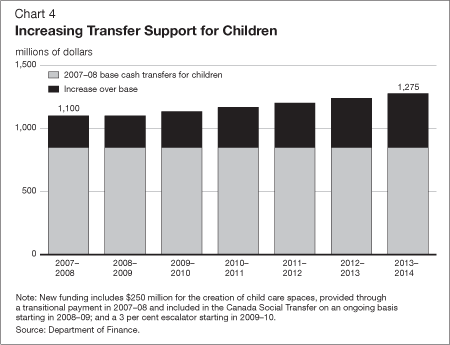
This transfer to provinces and territories is only one way that the federal government provides support for children.
The Government of Canada will provide nearly $5.6 billion in 2007-08 in support of early learning and child care through transfers, direct spending and tax measures:
- $1.1 billion in cash transfers to provinces and territories.
- $2.4 billion annually through monthly payments to parents for every child under the age of 6 through the Universal Child Care Benefit.
- $695 million in recognition of child care expenses through the child care expense deduction.
- Budget 2007 provides about $1.5 billion per year in tax support for families with children through the new child tax credit.
Supporting Social Programs
In addition to the new investments for post-secondary education and child care spaces, the CST supports social programs that benefit some of Canada's most vulnerable. The CST supports provincial and territorial programs and services for low-income Canadians, helping to lessen the effects of poverty and support participation in the workforce. Examples of programs and services include income support, job counselling services, civil legal aid, and certain health benefits for low-income Canadians.
Funding in support of social assistance and social services will increase to $6.2 billion in 2007-08, nearly $700 million higher than in 2006-07 due to the increase in CST base funding and the investments to move the CST to an equal per capita cash allocation. As a result of the 3-per-cent annual escalator, this funding will increase to $7.2 billion by 2013-14.
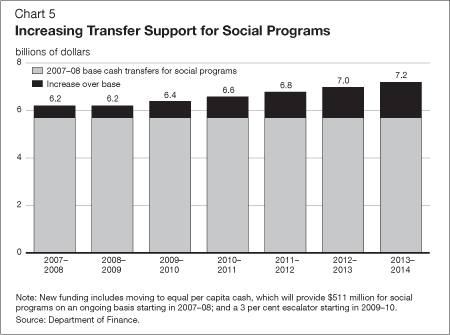
This transfer to provinces and territories is only one way that the federal government provides support for social assistance and social services.
The Government of Canada will provide about $25 billion in 2007-08 in support of social assistance, social services and income support:
- $6.2 billion in cash transfers to provinces and territories through the CST, an increase of nearly $700 million over 2006-07 levels.
- $9.5 billion to support children, including the Canada Child Tax Benefit and the Children's Special Allowance.
- $700 million to support persons with disabilities, including Labour Market Framework Agreements for Persons with Disabilities, the disability tax credit, and other measures. Budget 2007 announces the introduction of a new Registered Disability Savings Plan to improve the financial security and well-being of children with severe disabilities.
- $1.4 billion to provide basic social development programs for First Nations in areas of federal responsibility.
- $3.3 billion to support youth and housing, as well as programs for legal aid and immigration and refugee settlement.
- $3.7 billion to support low- and modest-income Canadians through the goods and services tax (GST) credit.
- $550 million in support for low- and modest-income working Canadians through the Working Income Tax Benefit, as announced in Budget 2007.
The CST Will Grow by $3.7 billion by 2013-14
Budget 2007 will add $687 million to the CST base in 2007-08. Starting in 2008-09, a further $800 million for post-secondary education and $250 million for the creation of child care spaces will be added to the CST base. Beginning in 2009-10, this funding will be escalated by 3 per cent annually.
As a result, the CST will increase from its 2006-07 level of $8.5 billion in cash transfers to over $12.2 billion by 2013-14, a $3.7-billion increase. Taken together, these actions are providing long-term, predictable and growing support for social priorities.
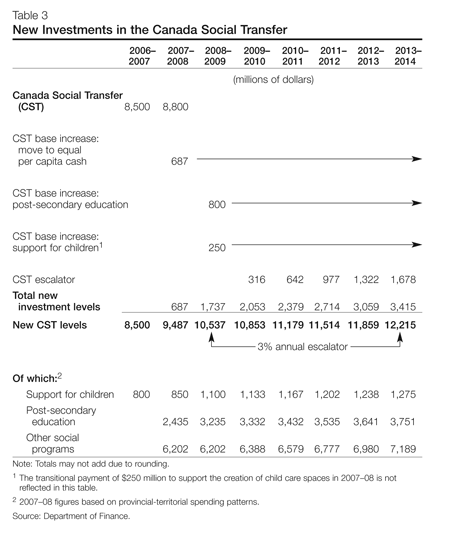
A New Approach to Labour Market Training
Canada already has a well-educated, highly skilled and mobile workforce, which has contributed to one of the most flexible and adaptable labour markets among OECD countries. In Advantage Canada, Canada's New Government recognized that we must never take our strength for granted, and that we must move forward together to meet the new labour market challenges facing Canada, including growing labour shortages and demographic challenges as our population ages.
To meet these new challenges, Budget 2007 delivers on a commitment to a new, more comprehensive approach to labour market training that will help provide training to those who need it, including under-represented groups, while also clarifying roles and responsibilities by recognizing that provinces and territories are best placed to design and deliver this programming. It does so by proposing a three-pronged strategy of a new approach to labour market training. More details can be found in Chapter 5 of The Budget Plan in the "Knowledge Advantage" section.
The Government will move forward to complete the transfer of responsibility for the delivery of Employment Insurance (EI) employment benefits and support measures to those provinces and territories that do not currently have full transfer Labour Market Development Agreements-Newfoundland and Labrador, Prince Edward Island, Nova Scotia, British Columbia and Yukon. These programs help EI clients find and maintain employment. Once agreements with these provinces and territories are reached, all of the approximately $2 billion in EI labour market programming will be delivered across Canada by the provinces and territories.
Budget 2007 proposes to invest $500 million annually starting in 2008-09 under a new labour market strategy to be developed with provinces and territories. The funding, to be allocated on an equal per capita basis, will be used to provide training opportunities for those unable to access training under current EI programs, and to encourage employers to provide more training to their workers. The Government will work with provinces and territories over the coming year to determine how this can best be achieved. The Government is prepared to consider providing future growth in funding for labour market programs after consultations with provinces and territories on how best to make use of new investments in labour market training and ensure reporting and accountability to Canadians.
The Government will also explore the feasibility of transferring to provinces and territories well over $500 million of annual funding associated with existing federal labour market programs for youth, older workers and persons with disabilities for the delivery of these programs under the above strategy.
Through increased funding and greater emphasis on provincial and territorial delivery of labour market programs, the Government is meeting its commitment to provide a new approach to labour market training. This approach respects the primary role and responsibility that provinces and territories have in the design and delivery of training programs. It ensures an ongoing federal role in helping to enable provinces and territories to deliver integrated and one-stop, seamless labour market programming to all Canadians, regardless of their employment status, that can be tailored to the specific needs of the individual and employers.
| Table 4 New Support for Labour Market Training (millions of dollars) |
|||||||
| 2008-2009 | 2009-2010 | 2010-2011 | 2011-2012 | 2012-2013 | 2013-2014 | Total | |
|---|---|---|---|---|---|---|---|
| Total new support for labour market training | 500 | 500 | 500 | 500 | 500 | 500 | 3,000 |
| Source: Department of Finance. | |||||||
The transfers and programs discussed above are not the only way that the federal government provides labour market training support.
The Government of Canada will provide almost $3.5 billion in 2007-08 in support of labour market programming through direct spending and tax measures:
- $2.2 billion for Employment Insurance Part II employment benefits and support measures and pan-Canadian activities.
- $340 million for the Aboriginal Human Resources Development Strategy, which assists Aboriginal people to prepare for, find and keep jobs, and $26 million for the Aboriginal Skills and Employment Partnership initiative, which includes $5 million from Budget 2007.
- $310 million for the Youth Employment Strategy, which helps young people, particularly those facing barriers to employment, gain the skills, work experience and abilities they need to make a successful transition to the workplace.
- $220 million for the Labour Market Framework Agreements for Persons with Disabilities to assist provinces and territories in improving the employment situation of Canadians with disabilities, and $30 million for the Opportunities Fund for Persons with Disabilities to assist persons with disabilities to prepare for and obtain employment.
- $100 million for the Apprenticeship Incentive Grant to support apprentices who have completed the first and second year of their apprenticeship in a Red Seal Program and $200 million for the Apprenticeship Job Creation Tax Credit to encourage employers to hire new apprentices.
- $45 million for the Targeted Initiative for Older Workers, which is a national cost-shared program to help older workers in vulnerable communities who have lost their jobs.
Providing Long-Term Predictable Support for Infrastructure
Canada needs modern, world-class infrastructure to make it a global leader for today and future generations, and to create a cleaner Canada. Modern, cutting-edge infrastructure matters to Canadians. It helps move people and goods to markets, allowing the economy to grow and prosper. Through public transit and water treatment systems, infrastructure investments will mean a cleaner, greener Canada.
While comparatively large infrastructure investments were made in the 1950s and 1960s, spending by all orders of government on public infrastructure as a proportion of gross domestic product declined over the subsequent three decades. After the fiscal restraint of the mid-1990s, investment in infrastructure has begun to rebound, but continued rapid growth in trade and environmental challenges are creating increased pressure on Canada's infrastructure.
Canada's New Government committed to early action in Budget 2006. Infrastructure support for provinces, territories and municipalities will have been increased to $5 billion per year by 2009-10, a level eight times greater than those recorded during the 1994-95 to 2004-05 period.
As well as taking early action, Budget 2006 committed to put in place a new long-term plan for infrastructure support that would provide greater certainty to provinces, territories and municipalities, reflecting the long time spans involved in planning and building major infrastructure projects. Advantage Canada then set out the key elements of the Government's long-term plan for infrastructure.
Budget 2007 delivers on the Government's commitment by extending federal infrastructure support to provinces, territories and municipalities through to 2013-14. This approach provides greater predictability, flexibility and accountability, and makes an important contribution towards the efforts of Canada's New Government in the areas of the economy, the environment and energy security. In total, Budget 2007 provides more than $16 billion towards the plan, which will include:
- Extending the Gas Tax Fund for municipalities.
- A Building Canada Fund, to be allocated among provinces and territories on an equal per capita basis.
- A national fund for gateways and border crossings, to be awarded on a merit basis.
- A national fund for public-private partnerships, to be awarded among projects on a merit basis.
- An annual amount of $25 million to be provided to each province and territory to support investments in national priorities throughout the country.
- Additional funding for the Asia-Pacific Gateway and Corridor Initiative.
Including the infrastructure funding in Budget 2006 and the increase from 57.1 per cent to 100 per cent in the GST rebate for municipalities, the new long-term plan will total $33 billion over the next seven years.
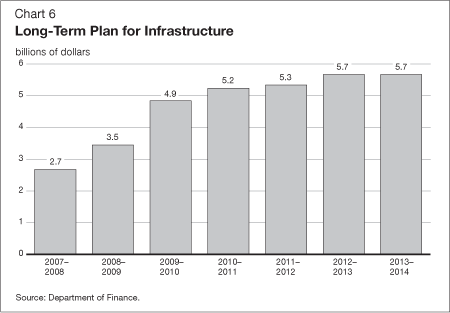
These actions deliver long-term funding support for infrastructure that gives provinces, territories and municipalities the stability, certainty and support they need to strengthen Canada's infrastructure system. More details on these actions can be found in Chapter 5 of The Budget Plan in the "Infrastructure Advantage" section.
The Canada ecoTrust for Clean Air and Climate Change
As well as providing long-term funding, Canada must be prepared to be flexible and meet evolving challenges. In that respect, more than $1.5 billion will be provided to help provinces and territories address the priorities of climate change and clean air.
Budget 2007 confirms the arrangements for the Canada ecoTrust for Clean Air and Climate Change by establishing a third-party trust to provide more than $1.5 billion to provinces and territories that identify major projects that target real reductions in greenhouse gas emissions and air pollutants.
The Canada ecoTrust for Clean Air and Climate Change will provide provinces and territories with the flexibility to draw down the funds over three years or according to their respective schedule and priorities, upon passage of legislation. The Canada ecoTrust for Clean Air and Climate Change will be allocated on a per capita basis and will provide a minimum of $15 million per province and $5 million per territory to support efforts to develop technology, improve energy efficiency, and undertake other projects that will result in significant environmental benefits.
Providing Growing Support to Provinces and Territories
The actions in Budget 2006 and Budget 2007 will put support to provinces and territories on a long-term, predictable and principled footing as part of the Government's plan to restore fiscal balance in Canada. Budget 2007 will deliver an additional $39 billion over seven years.
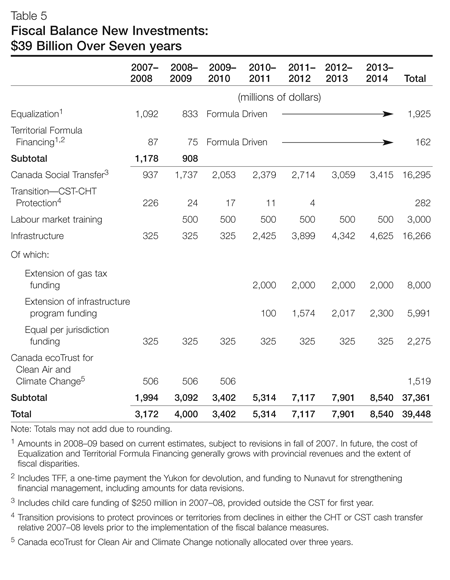
The Equalization and Territorial Formula Financing programs are both legislated to 2013-14. Equalization payments will grow to more than $12.7 billion in 2007-08, approximately $1.5 billion more than in 2006-07. TFF payments will grow to $2.2 billion, $115 million more than in 2006-07. Future payments in both programs will be formula-driven and responsive to changes in the fiscal situation of provinces and territories.
Other transfers are also put on a long-term, predictable and growing track to 2013-14. Altogether, funding under these transfers will have grown to $48.7 billion by 2013-14, a 60-per-cent increase compared to 2005-06:
- Canada Health Transfer-Long-term support that will continue to grow by 6 per cent annually to reach $30.3 billion in 2013-14.
- Canada Social Transfer-Long-term support that will continue to grow by 3 per cent annually to reach $12.2 billion in 2013-14.
- Labour market training-Long-term support that will provide $3 billion in total support by 2013-14.
- Infrastructure-Long-term support that will provide $5.7 billion in 2013-14 for provincial, territorial and municipal infrastructure.
The Canada ecoTrust for Clean Air and Climate Change will provide support of more than $1.5 billion to provinces and territories.
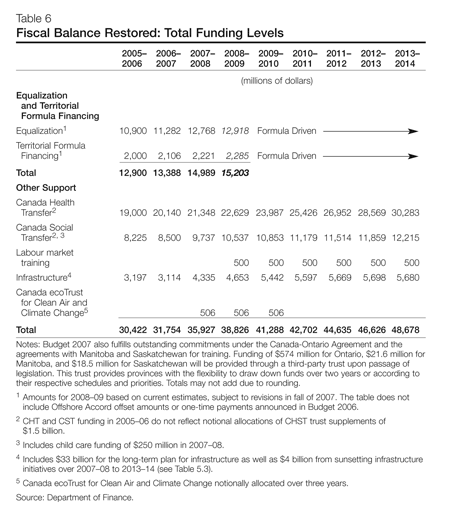
Restoring Fiscal Balance With Canadian Taxpayers
Canadians pay too much in taxes. The Government is working to restore fiscal balance with Canadians, and has and will continue to reduce taxes so that it only raises the revenues that it needs to fulfill its responsibilities.
More Tax Relief for Canadians
Budget 2007 delivers $9.7 billion in total tax relief. This leaves more money in the pockets of Canadians and provides businesses with a more competitive tax environment.
A New Approach to Allocating Surpluses
Budget 2006 acknowledged concerns over the transparency of federal budget planning. In Advantage Canada, the Government introduced a Tax Back Guarantee to ensure that all Canadians benefit directly from federal debt reduction through lower taxes. Budget 2007 goes further by proposing to legislate the Tax Back Guarantee. This ensures that as the Government reduces its debt, it will be required to use the interest savings from this debt reduction to lower personal income taxes. Any unplanned surpluses will be applied to reduce federal debt, and all associated interest savings will be used to further reduce personal income taxes. The Tax Back Guarantee makes more transparent for Canadians how the Government intends to use federal surpluses and ensures that such surpluses directly benefit Canadians.
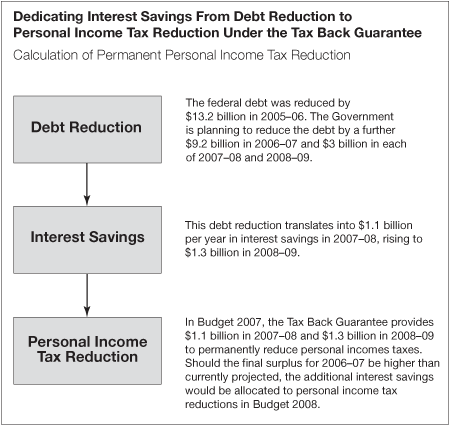
This approach builds on the actions taken in 2006 to enhance transparency in budget planning: the Government established a Parliamentary Budget Officer, made a commitment to provide updates of fiscal projections for the current fiscal year on a quarterly basis, improved the transparency of financial information in the budget and the Public Accounts of Canada, and introduced a two-year budget-planning horizon.
Disciplined Spending
Budget 2007 continues the Government's disciplined spending by limiting the growth in program spending, on average, to below the rate of growth of the economy and implementing a new Expenditure Management System.
Clarifying Roles and Responsibilities and Limiting the Use of the Federal Spending Power
Canada's New Government is guided by the principle of enhancing the accountability of governments through the clarification of their respective roles and responsibilities. Budget 2007 continues to deliver on this commitment. Transfers have been reformed to clarify their purpose and federal contribution, consistent with the recognition that provinces and territories are best placed to deliver services in their areas of responsibility such as health care, post-secondary education and labour market training.
The tax cuts that are being provided in Budget 2006 and Budget 2007 mean that excess federal revenues are being used primarily to reduce taxes rather than launch new federal programs in areas that are primarily of provincial and territorial responsibility.
New spending has focused on areas of federal responsibility and on supporting provinces and territories-through strengthened fiscal arrangements in areas of shared priorities. To the extent that new initiatives have been introduced in areas of primary provincial and territorial responsibility, it has been done in a respectful manner, at the request of provinces and territories.
Budget 2007 reconfirms the Government's commitment to limit the use of the federal spending power to ensure that:
- New cost-shared programs in areas of provincial responsibility have the consent of the majority of provinces to proceed.
- Provinces and territories have the right to opt out of cost-shared federal programs with compensation if they offer similar programs with comparable accountability structures.
To support the commitment to limit the use of the spending power, the Government will report, starting with this budget and in all future budgets, on new investments in areas of core federal and shared responsibility and in transfers to support provinces and territories.
Canada's New Government has committed to respecting roles and responsibilities by not spending in areas of provincial-territorial jurisdiction. In order to monitor progress, the Government will report on the nature of federal spending in each budget.
The table below highlights spending in Budget 2007 according to area of responsibility.
- Federal/shared responsibility: Refers to new spending in areas that are considered core federal responsibility, including defence, international assistance, national parks and public security, and in areas of shared priority, such as agriculture, environment, health care and immigration.
- Restoring fiscal balance/funding to provinces and territories: Refers to new funding that is being provided to provinces and territories. This includes additional funding for Equalization and Territorial Formula Financing, as well as support for shared and provincial-territorial responsibilities, such as post-secondary education, early childhood development, child care, social services, infrastructure, labour market training and modernizing the health care system.
|
Budget 2007 (percentage) |
||||
| 2006-07 | 2007-08 | 2008-09 | Average | |
|---|---|---|---|---|
| New Spending | ||||
| Federal/shared responsibility | 29 | 45 | 32 | 35 |
| Restoring fiscal balance/ funding to provinces and territories |
71 | 55 | 68 | 65 |
The Government will continue to further clarify roles and responsibilities, and will explore with provinces and territories ways to formalize its commitment to limit the use of the federal spending power to ensure respect for provincial-territorial responsibility.
Building a Stronger Economic Union
Restoring fiscal balance is only a means to an end. Canadians want their governments to move collectively beyond old disputes over funding issues and work more effectively and collaboratively together. They want their governments to deliver results for people and families through better programs. The funding provided in this budget will help achieve this important goal. Canadians also want their governments to build a stronger economic union, which is vital to our future prosperity and standard of living.
Advantage Canada outlined a comprehensive strategy aimed at fostering a stronger economic union. The plan committed the federal government to engage with provinces and territories to enhance internal trade and labour mobility, to create a common securities regulator, and to encourage provinces and territories to move ahead with the harmonization of sales taxes with the GST.
Progress has recently been made in working with provinces and territories on a number of fronts, but more must be done to reduce structural impediments to a more productive and competitive economy.
Over the past months, encouraging progress has been made in working with provinces and territories on fostering a stronger economic union, notably:
- The Trade, Investment and Labour Mobility Agreement signed in 2006 between Alberta and British Columbia goes much further than the Agreement on Internal Trade, and is serving as a model for ongoing discussions on improving internal trade across Canada.
- In September 2006, all provinces reached agreement on an ambitious action plan to reduce barriers to interprovincial trade and enhance labour mobility.
- The October 2006 Canada-Ontario agreement on single corporate tax will reduce the annual compliance costs to Ontario businesses by $100 million.
- At the December 2006 Finance Ministers Meeting, Ministers agreed to work together in three specific areas-reduced paper burden on businesses, tax harmonization and labour mobility-and to discuss progress at the next Finance Ministers Meeting expected in June 2007.
Budget 2007: Concrete Steps to a Stronger Economic Union
Budget 2007 delivers a comprehensive set of proposals to further strengthen the economic union. Specifically, Budget 2007:
- Delivers comprehensive tax relief that leaves more money in the pockets of Canadians and provides businesses with the competitive tax environment needed to increase prosperity.
- Provides a financial incentive to provinces to eliminate or accelerate the elimination of their capital taxes.
- Implements a Working Income Tax Benefit to make work pay for low-and modest-income Canadians.
- Strengthens our labour markets through a new approach to labour market training and by attracting and retaining skilled and experienced immigrants, making improvements to the Temporary Foreign Worker Program and establishing the Foreign Credential Referral Office.
- Delivers science and technology investments that complement significant new investments in post-secondary education, and that will sustain Canada's leadership in primary research and help commercialize knowledge by better aligning research investments with the needs of businesses.
- Launches a plan to create a Canadian advantage in global capital markets.
- Helps Canadian businesses take advantage of expanding global market opportunities through a Global Commerce Strategy.
Fiscal Balance Has Been Restored
Budget 2007 fulfills the Government's commitment to restore fiscal balance. It is a comprehensive, long-term plan that responds to concerns raised by provinces and territories. It is a sustainable, affordable plan that provides additional funding to provinces and territories of more than $39 billion over seven years. Canada's New Government is restoring fiscal balance by:
- Renewing and strengthening Equalization and Territorial Formula Financing by returning these programs to a principles-based approach while respecting the federal government's existing commitments to certain provinces.
- Putting fiscal support to provinces and territories for health care, post-secondary education, child care spaces, labour market training and infrastructure on a long-term, predictable footing.
- Increasing budget transparency and accountability for taxpayers' money by using a new approach to directing unanticipated surpluses to personal income tax reductions through the Tax Back Guarantee.
- Bringing more clarity to the delineation of roles and responsibilities among governments in the federation by focusing on core federal responsibilities and limiting the use of the federal spending power in areas of provincial-territorial responsibility.
- Taking concrete steps to a stronger economic union.
A Better Future for Canada
Canada's New Government promised to restore fiscal balance, and Budget 2007 delivers on this commitment.
The Government will maintain fiscal balance by respecting the principles it has established. It will also work on the economic plan set out in Advantage Canada to build a stronger economy and make Canada a more prosperous country by:
- Making its spending more effective, results-oriented and focused on core areas of federal responsibility.
- Working with provinces and territories to accelerate progress on more open and free internal markets.
- Reducing taxes and improving the tax system to enhance incentives to save, work and invest, and strengthen our international tax competitiveness.
- Pursuing a more competitive business tax system including by encouraging the harmonization of provincial retail sales taxes with the GST, effectively eliminating retail sales taxes on business inputs and capital goods.
- Working with provinces and other partners to create a Canadian advantage in global capital markets, including a common securities regulator that administers proportionate, more principles-based regulations for the benefit of investors, businessess and the economy.
These are important issues for all Canadians. In the months ahead, Canada's New Government will be looking to provinces, territories and stakeholders to work together to accelerate progress so that all Canadians can benefit from a more prosperous and dynamic Canadian economy and society.
| Table 7 A Stronger Federation (millions of dollars) |
||||
| 2006-07 | 2007-08 | 2008-09 | Total | |
|---|---|---|---|---|
| Equalization1 | 1,092 | 833 | 1,925 | |
| Territorial Formula Financing1, 2 | 54 | 87 | 75 | 216 |
| Canada Social Transfer | ||||
| Move to equal per capita cash | 687 | 687 | 1,374 | |
| Post-secondary education investment | 800 | 800 | ||
| Creating child care spaces3 | 250 | 250 | 500 | |
| Transition-CHT-CST | 226 | 24 | 250 | |
| Subtotal-CST | 1,163 | 1,761 | 2,924 | |
| Labour market training | 500 | 500 | ||
| Equal per jurisdiction funding for infrastructure | 325 | 325 | 650 | |
| Canada ecoTrust for Clean Air and Climate Change | 1,519 | 1,519 | ||
| Outstanding provincial agreements | 614 | 614 | ||
| Total-A Stronger Federation | 2,187 | 2,667 | 3,494 | 8,348 |
| Less: Funding included in previous budgets4 | 122 | 553 | 760 | 1,435 |
| Net total-fiscal balance | 2,066 | 2,114 | 2,734 | 6,913 |
| 1 Amounts for 2008-09 based on current estimates, subject to revisions in fall 2007. 2 Includes Territorial Formula Financing, one-time payments for the Northwest Territories for a large tax refund and Yukon for devolution, funding to Nunavut for strengthening financial management, and amounts for data revisions. 3 Payment in 2007-08 outside the CST. 4 The Canada Social Transfer initiatives, the labour market strategy and the outstanding provincial agreements are partly funded from existing sources of funds. |
||||
Annex 1
Recent Evolution of Fiscal Balance in Canada
The fiscal position of the federal and provincial-territorial governments remains strong
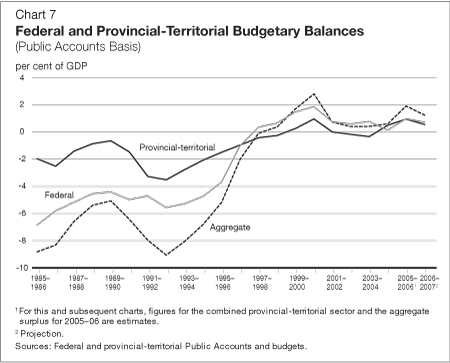
All provincial-territorial governments were in surplus in 2005-06
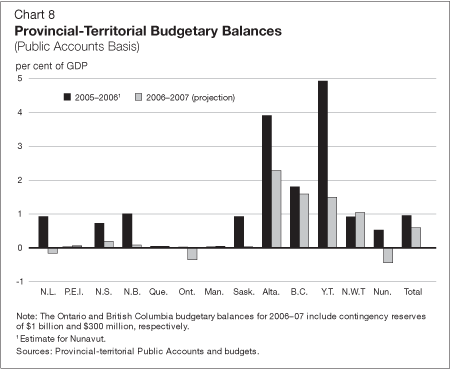
The gap between federal and provincial-territorial revenues is widening.
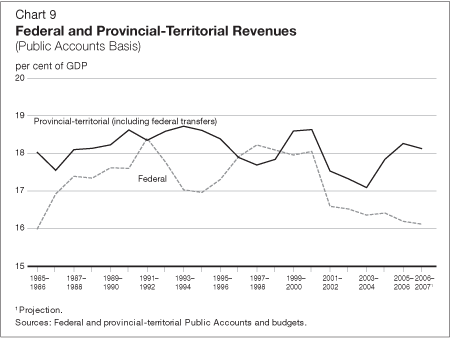
.while the gap between federal and provincial-territorial program spending remains stable
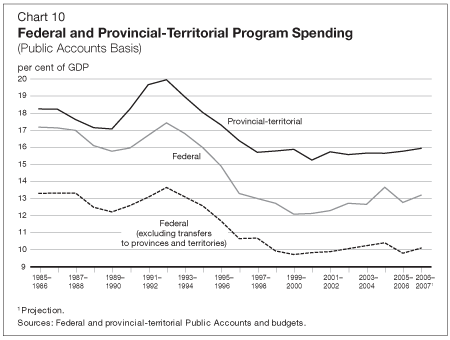
Debt burdens continue to decline, although the federal burden remains higher.
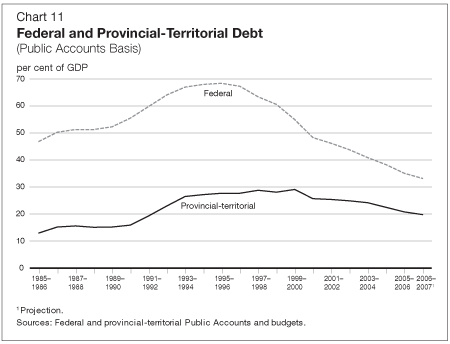
.but debt charges are falling as a share of total revenues
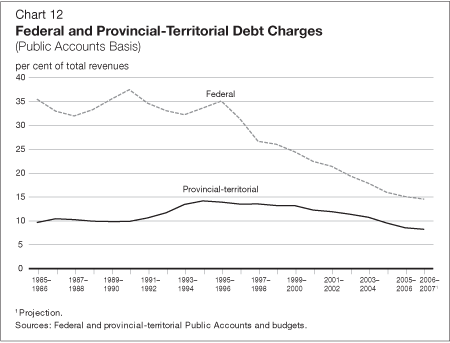
Annex 2
Restoring Fiscal Balance for a Stronger Federation
The plan to restore fiscal balance ensures that the Government of Canada provides significant support to provinces, territories and municipalities
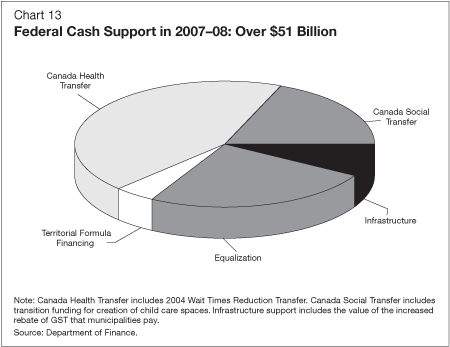
The new Equalization formula will ensure that all provinces can provide reasonably comparable programs and services
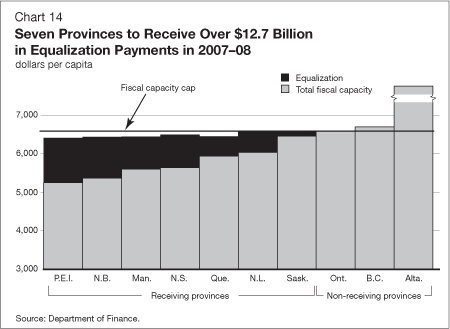
The new Territorial Formula Financing program is stronger and better recognizes the unique circumstances in the north
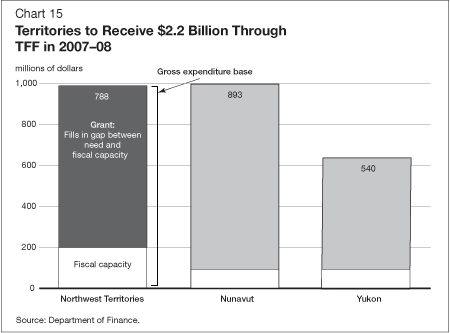
The Canada Health Transfer has a legislated escalator of 6 per cent a year and will provide growing funding for health care
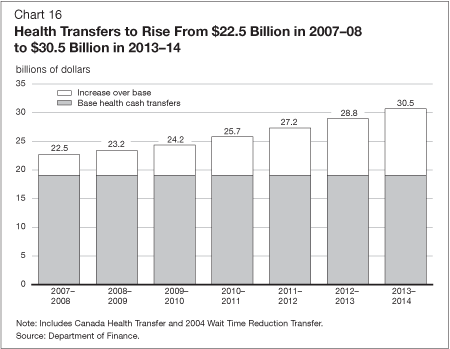
New investments in the Canada Social Transfer and a new legislated escalator of 3 per cent a year will provide growing funding for social priorities
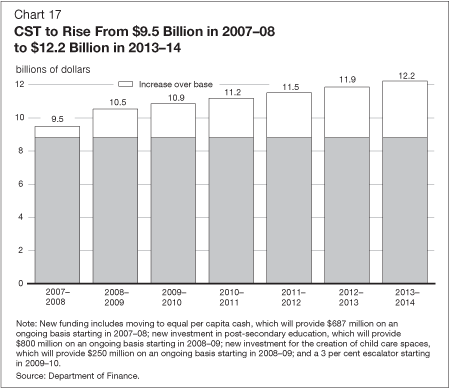
Combined transfer support for health and social programs will be much larger than before, and will grow at a predictable rate
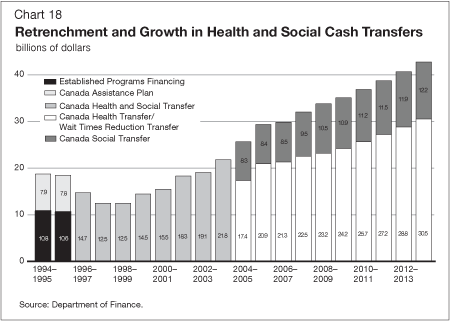
Infrastructure funding will be put on long-term basis to provide provinces, territories and municipalities the support they need to strengthen infrastructure
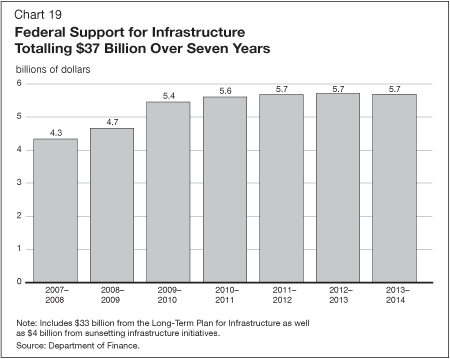
Budget 2007 also provides support for other priorities
| Table 8 Additional Support for Provinces and Territories (millions of dollars) |
|||
| 2007-08 | 2008-09 | 2009-10 | |
|---|---|---|---|
| Labour market training | 500 | 500 | |
| Canada ecoTrust for Clean Air and Climate Change | 506 | 506 | 506 |
| Patient Wait Times Guarantee Trust | 204 | 204 | 204 |
| Immunization Trust | 100 | 100 | 100 |
| Total | 810 | 1,310 | 1,310 |
| Notes: Labor market training ongoing to 2013-14. Totals may not add due to rounding. Source: Department of Finance. |
|||
With fiscal balance restored, transfers will grow significantly and will be larger than ever
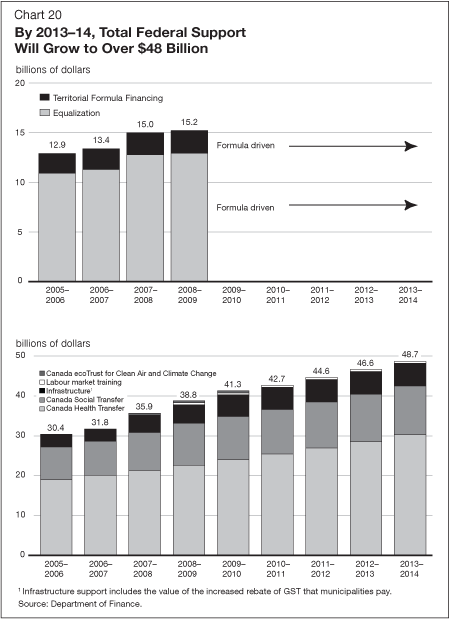
Annex 3
Major Federal Transfers
| Table 9 Equalization Entitlements (1993-94 to 2007-08) (millions of dollars) |
|||||||||
| Year | N.L. | P.E.I. | N.S. | N.B. | Que. | Man. | Sask. | B.C. | Canada |
|---|---|---|---|---|---|---|---|---|---|
| 1993-94 | 900 | 175 | 889 | 835 | 3,878 | 901 | 486 | - | 8,063 |
| 1994-95 | 958 | 192 | 1,065 | 927 | 3,965 | 1,085 | 413 | - | 8,607 |
| 1995-96 | 932 | 192 | 1,137 | 876 | 4,307 | 1,051 | 264 | - | 8,759 |
| 1996-97 | 1,030 | 208 | 1,182 | 1,019 | 4,169 | 1,126 | 224 | - | 8,959 |
| 1997-98 | 1,093 | 238 | 1,302 | 1,112 | 4,745 | 1,053 | 196 | - | 9,738 |
| 1998-99 | 1,068 | 238 | 1,221 | 1,112 | 4,394 | 1,092 | 477 | - | 9,602 |
| 1999-00 | 1,169 | 255 | 1,290 | 1,183 | 5,280 | 1,219 | 379 | 125 | 10,900 |
| 2000-01 | 1,112 | 269 | 1,404 | 1,260 | 5,380 | 1,314 | 208 | - | 10,948 |
| 2001-02 | 1,055 | 256 | 1,315 | 1,202 | 4,679 | 1,362 | 200 | 240 | 10,310 |
| 2002-03 | 875 | 235 | 1,122 | 1,143 | 4,004 | 1,303 | 106 | 71 | 8,859 |
| 2003-04 | 766 | 232 | 1,130 | 1,142 | 3,764 | 1,336 | - | 320 | 8,690 |
| 2004-051 | 762 | 277 | 1,313 | 1,326 | 4,155 | 1,607 | 652 | 682 | 10,774 |
| 2005-06 | 861 | 277 | 1,344 | 1,348 | 4,798 | 1,601 | 82 | 590 | 10,900 |
| 2006-072 | 632 | 291 | 1,386 | 1,451 | 5,539 | 1,709 | 13 | 260 | 11,282 |
| 2007-083 | 477 | 294 | 1,308 | 1,477 | 7,160 | 1,826 | 226 | - | 12,768 |
| Note: Totals may not add due to rounding. 1 Entitlements for 2004-05 exclude $150 million in additional Equalization related to the 2004 renewal. 2 Figures for 2006-07 are as outlined in Budget 2006 and do not include one-time adjustments. 3 Figures for 2007-08 are as proposed in Budget 2007. Source: Department of Finance. |
|||||||||
| Table 10 Territorial Formula Financing Entitlements (1993-94 to 2007-08) (millions of dollars) |
||||
| Year | Yukon | Northwest Territories1 | Nunavut1 | Canada |
|---|---|---|---|---|
| 1993-94 | 289 | 861 | - | 1,150 |
| 1994-95 | 289 | 892 | - | 1,181 |
| 1995-96 | 291 | 906 | - | 1,197 |
| 1996-97 | 289 | 908 | - | 1,197 |
| 1997-98 | 307 | 921 | - | 1,229 |
| 1998-99 | 310 | 935 | - | 1,246 |
| 1999-00 | 319 | 493 | 520 | 1,333 |
| 2000-01 | 336 | 310 | 566 | 1,212 |
| 2001-02 | 359 | 546 | 613 | 1,518 |
| 2002-03 | 372 | 588 | 656 | 1,616 |
| 2003-04 | 435 | 626 | 692 | 1,754 |
| 2004-05 | 466 | 678 | 756 | 1,900 |
| 2005-06 | 487 | 714 | 799 | 2,000 |
| 2006-072 | 506 | 739 | 825 | 2,070 |
| 2007-083 | 540 | 788 | 893 | 2,221 |
| Note: Totals may not add due to rounding. 1 Nunavut was created on April 1, 1999. After this date, TFF payments previously made to the Northwest Territories were divided between the Northwest Territories and Nunavut. 2 Figures for 2006-07 are as outlined in Budget 2006 and do not include one-time adjustments or supplementary payments, which increased the total payments to $2,106 million. 3 Figures for 2007-08 are as proposed in Budget 2007. Source: Department of Finance. |
||||
| Table 11 Health and Social Cash Transfers (1993-94 to 2007-08) (millions of dollars) |
|||||||
| Year | N.L. | P.E.I. | N.S. | N.B. | Que. | Ont. | |
|---|---|---|---|---|---|---|---|
| 1993-94 | EPF | 236 | 54 | 375 | 305 | 2,919 | 3,913 |
| CAP | 179 | 38 | 263 | 205 | 2,652 | 2,388 | |
| 1994-95 | EPF | 228 | 53 | 366 | 297 | 2,856 | 3,829 |
| CAP | 195 | 36 | 267 | 204 | 2,694 | 2,509 | |
| 1995-96 | EPF | 219 | 52 | 357 | 289 | 2,787 | 3,707 |
| CAP | 195 | 36 | 267 | 204 | 2,694 | 2,509 | |
| 1996-97 | CHST | 345 | 71 | 508 | 401 | 4,512 | 4,787 |
| 1997-98 | CHST | 283 | 61 | 432 | 338 | 3,900 | 3,885 |
| 1998-99 | CHST | 276 | 61 | 432 | 338 | 3,863 | 3,810 |
| 1999-00 | CHST | 289 | 71 | 488 | 388 | 3,983 | 4,715 |
| 2000-01 | CHST | 296 | 74 | 512 | 409 | 4,179 | 5,135 |
| 2001-02 | CHST | 323 | 86 | 585 | 479 | 4,718 | 6,527 |
| 2002-03 | CHST | 331 | 89 | 604 | 485 | 4,809 | 6,897 |
| 2003-04 | CHST | 360 | 96 | 657 | 527 | 5,254 | 7,640 |
| HRT | 16 | 4 | 30 | 24 | 237 | 387 | |
| 2004-05 | CHT | 264 | 70 | 477 | 383 | 3,838 | 5,710 |
| CST | 144 | 38 | 261 | 209 | 2,097 | 3,081 | |
| HRT | 24 | 6 | 44 | 35 | 354 | 582 | |
| 2005-06 | CHT | 342 | 92 | 622 | 499 | 5,043 | 7,698 |
| CST | 145 | 39 | 264 | 212 | 2,142 | 3,150 | |
| 2006-07 | CHT | 333 | 90 | 610 | 489 | 4,994 | 7,584 |
| CST | 144 | 39 | 264 | 212 | 2,159 | 3,153 | |
| 2007-08 | CHT | 346 | 94 | 636 | 510 | 5,225 | 8,107 |
| CST | 147 | 40 | 270 | 217 | 2,220 | 3,699 | |
| Child Care | 4 | 1 | 7 | 6 | 58 | 97 | |
| Year | Man. | Sask. | Alta. | B.C. | Y.T. | N.W.T. | Nun. | Canada |
|
(millions of dollars) |
||||||||
| 1993-94 | 453 | 408 | 1,012 | 1,349 | 13 | 22 | - | 11,059 |
| 308 | 226 | 613 | 841 | 12 | 28 | - | 7,751 | |
| 1994-95 | 442 | 389 | 980 | 1,353 | 12 | 22 | - | 10,829 |
| 303 | 241 | 524 | 882 | 11 | 31 | - | 7,897 | |
| 1995-96 | 435 | 390 | 964 | 1,400 | 12 | 24 | - | 10,637 |
| 303 | 241 | 520 | 835 | 11 | 31 | - | 7,846 | |
| 1996-97 | 598 | 500 | 1,112 | 1,843 | 18 | 47 | - | 14,742 |
| 1997-98 | 507 | 430 | 878 | 1,724 | 19 | 44 | - | 12,500 |
| 1998-99 | 507 | 433 | 894 | 1,827 | 19 | 41 | - | 12,500 |
| 1999-00 | 587 | 513 | 1,311 | 2,105 | 20 | 9 | 22 | 14,500 |
| 2000-01 | 623 | 529 | 1,323 | 2,373 | 20 | 4 | 22 | 15,500 |
| 2001-02 | 735 | 640 | 1,508 | 2,638 | 21 | 19 | 21 | 18,300 |
| 2002-03 | 747 | 633 | 1,593 | 2,851 | 21 | 20 | 21 | 19,100 |
| 2003-04 | 814 | 717 | 1,774 | 2,916 | 23 | 23 | 24 | 20,825 |
| 37 | 31 | 100 | 131 | 1 | 1 | 1 | 1,000 | |
| 2004-05 | 595 | 507 | 1,237 | 2,138 | 17 | 18 | 18 | 15,270 |
| 325 | 277 | 650 | 1,169 | 9 | 10 | 10 | 8,280 | |
| 55 | 47 | 150 | 197 | 1 | 2 | 1 | 1,500 | |
| 2005-06 | 780 | 692 | 1,654 | 2,824 | 21 | 20 | 22 | 20,310 |
| 331 | 300 | 605 | 1,200 | 9 | 7 | 10 | 8,415 | |
| 2006-07 | 769 | 721 | 1,676 | 2,812 | 21 | 17 | 23 | 20,140 |
| 332 | 326 | 630 | 1,216 | 9 | 6 | 10 | 8,500 | |
| 2007-08 | 804 | 668 | 1,804 | 3,090 | 22 | 19 | 24 | 21,348 |
| 341 | 284 | 983 | 1,257 | 9 | 12 | 9 | 9,487 | |
| 9 | 7 | 26 | 33 | 0.2 | 0.3 | 0.2 | 250 | |
| Note: Totals may not add due to rounding. Includes cash transfers provided under Established Programs Financing (EPF) and the Canada Assistance Plan (CAP) up to 1995-96; the Canada Health and Social Transfer (CHST) up to 2003-04; the Health Reform Transfer (HRT) (2003-04 and 2004-05); the 2003 CHST cash supplement and 2004 CHST cash supplement for health based on notional drawdown schedules; the Canada Health Transfer and the Canada Social Transfer for 2004-05 and beyond; and the $250 million transitional payment for the creation of child care spaces in 2007-08. Excludes tax transfers. Source: Department of Finance. |
||||||||
Explanatory Notes for Provincial and Territorial Tables
The following explanatory notes apply to the provincial and territorial tables which follow.
Equalization for 2008-09: Based on current estimates. Numbers to be revised in the fall of 2007.
Canada Social Transfer: Includes child care transition funding in 2007-08 (provided outside the CST for this year only).
Canada Social Transfer and Canada Health Transfer: Includes Canada Health and Social Transfer supplements, which ended in 2005-2006.
Labour market training: Equal per capita share of $500-million in new labour market training funding beginning in 2008-09.
Infrastructure: Funding reflects provincial-territorial share of the Gas Tax Fund, the Building Canada Fund, the equal per jurisdiction funding, the Public Transit Fund and the Public Transit Capital Trust. It does not include the value of the increased rebate of the GST that municipalities pay, funding under sunsetting programs and amounts under the merit-based funds (i.e. the national fund for gateways and border crossings, the national fund for public-private partnership (P3) projects and the Asia-Pacific Gateway and Corridor Initiative). In total, the amounts under the excluded initiatives are: $2.197 billion in 2005-06, $2.214 billion in 2006-07, $2.338 billion in 2007-08 and $2.102 billion in 2008-09.
Canada ecoTrust for Clean Air and Climate Change: Share of $1.5 billion notionally allocated over three years beginning in 2007-08. Canada ecoTrust for Clean Air and Climate Change is referred to as "Canada ecoTrust" in the tables that follow.
Total does not include funding from the Immunization Trust or the Patient Wait Times Guarantee Trust.
Totals may not add due to rounding.
| Table 12 Canada (millions of dollars) |
||||
| 2005-06 | 2006-07 | 2007-08 | 2008-09 | |
|---|---|---|---|---|
| Equalization1 | 10,900 | 11,282 | 12,768 | 12,918 |
| Offshore Accord offsets1 | 216 | 386 | 624 | 983 |
| Territorial Formula Financing2 | 2,035 | 2,106 | 2,221 | 2,285 |
| Canada Health Transfer (CHT) | 20,310 | 20,140 | 21,348 | 22,629 |
| Transition CHT protection | 118 | |||
| Canada Social Transfer (CST)3 | 8,415 | 8,500 | 9,737 | 10,537 |
| Transition CST protection | 108 | 24 | ||
| New labour market training funding | 500 | |||
| Infrastructure | 1,000 | 900 | 1,997 | 2,551 |
| Canada ecoTrust | 506 | 506 | ||
| Total | 42,876 | 43,314 | 49,427 | 52,932 |
| Increase over 2005-06 | 438 | 6,551 | 10,057 | |
| See explanatory notes on page 66. 1 Assumes N.L. and N.S. will operate under previous program in 2007-08 and 2008-09; does not include one-time payment announced in Budget 2006. Offshore Accord offset amounts for 2008-09 based on current estimate. 2 Includes supplementary payments in Budget 2005 and Budget 2006; excludes one-time adjustment to TFF in 2006-07. 3 Includes child care funding of $250 million in 2007-08. |
||||
| Table 13 Newfoundland and Labrador (millions of dollars) |
||||
| 2005-06 | 2006-07 | 2007-08 | 2008-09 | |
|---|---|---|---|---|
| Equalization1 | 861 | 632 | 477 | 197 |
| Offshore Accord offsets1 | 189 | 329 | 494 | 757 |
| Canada Health Transfer2 | 342 | 333 | 347 | 361 |
| Canada Social Transfer | 145 | 144 | 151 | 162 |
| New labour market training funding | 8 | |||
| Infrastructure | 16 | 15 | 52 | 61 |
| Canada ecoTrust | 8 | 8 | ||
| Total | 1,553 | 1,453 | 1,529 | 1,554 |
| Increase over 2005-06 | -1011 | -25 | 0 | |
| Increase over 2005-06 (excluding Equalization and Offshore offsets) |
-12 | 54 | 96 | |
| See explanatory notes on page 66. 1 Based on current projections. For 2006-07, number does not include one-time payment announced in Budget 2006. For 2007-08 and 2008-09 assumes Newfoundland and Labrador operates under previous Equalization program. Numbers to be revised in fall of 2007. Offshore Accord offset amounts for 2008-09 based on current estimates. Equalization declines primarily due to growth in offshore revenues. 2 Includes transition CHT protection payment in 2007-08. |
||||
| Table 14 Prince Edward Island (millions of dollars) |
||||
| 2005-06 | 2006-07 | 2007-08 | 2008-09 | |
|---|---|---|---|---|
| Equalization | 277 | 291 | 294 | 310 |
| Canada Health Transfer1 | 92 | 90 | 95 | 99 |
| Canada Social Transfer | 39 | 39 | 41 | 44 |
| New labour market training funding | 2.1 | |||
| Infrastructure | 6 | 6 | 35 | 38 |
| Canada ecoTrust | 5 | 5 | ||
| Total | 414 | 426 | 470 | 498 |
| Increase over 2005-06 | 12 | 56 | 84 | |
| See explanatory notes on page 66. 1 Includes transition CHT protection payment in 2007-08. |
||||
| Table 15 Nova Scotia (millions of dollars) |
||||
| 2005-06 | 2006-07 | 2007-08 | 2008-09 | |
|---|---|---|---|---|
| Equalization1 | 1,344 | 1,386 | 1,308 | 1,294 |
| Offshore Accord offsets1 | 27 | 57 | 130 | 226 |
| Canada Health Transfer2 | 622 | 610 | 639 | 667 |
| Canada Social Transfer | 264 | 264 | 277 | 298 |
| New labour market training funding | 14 | |||
| Infrastructure | 29 | 26 | 73 | 89 |
| Canada ecoTrust | 14 | 14 | ||
| Total | 2,286 | 2,343 | 2,441 | 2,602 |
| Increase over 2005-06 | 57 | 155 | 316 | |
| See explanatory notes on page 66. 1 Based on current projections. For 2007-08 and 2008-09 assumes Nova Scotia operates under previous Equalization program. Numbers to be revised in fall of 2007. Offshore Accord offset amounts for 2008-09 based on current estimates. 2 Includes transition CHT protection payment in 2007-08. |
||||
| Table 16 New Brunswick (millions of dollars) |
||||
| 2005-06 | 2006-07 | 2007-08 | 2008-09 | |
|---|---|---|---|---|
| Equalization | 1,348 | 1,451 | 1,477 | 1,492 |
| Canada Health Transfer1 | 499 | 489 | 512 | 534 |
| Canada Social Transfer | 212 | 212 | 222 | 239 |
| New labour market training funding | 11 | |||
| Infrastructure | 23 | 21 | 64 | 76 |
| Canada ecoTrust | 11 | 11 | ||
| Total | 2,082 | 2,173 | 2,286 | 2,363 |
| Increase over 2005-06 | 91 | 203 | 281 | |
| See explanatory notes on page 66. 1Includes transition CHT protection payment in 2007-08. |
||||
| Table 17 Quebec (millions of dollars) |
||||
| 2005-06 | 2006-07 | 2007-08 | 2008-09 | |
|---|---|---|---|---|
| Equalization | 4,798 | 5,539 | 7,160 | 7,622 |
| Canada Health Transfer1 | 5,043 | 4,994 | 5,246 | 5,492 |
| Canada Social Transfer | 2,142 | 2,159 | 2,278 | 2,458 |
| New labour market training funding | 117 | |||
| Infrastructure | 233 | 208 | 413 | 542 |
| Canada ecoTrust | 117 | 117 | ||
| Total | 12,216 | 12,900 | 15,214 | 16,348 |
| Increase over 2005-06 | 685 | 2,999 | 4,133 | |
| See explanatory notes on page 66. 1 Includes transition CHT protection payment in 2007-08. |
||||
| Table 18 Ontario (millions of dollars) |
||||
| 2005-06 | 2006-07 | 2007-08 | 2008-09 | |
|---|---|---|---|---|
| Equalization | - | - | - | - |
| Canada Health Transfer | 7,698 | 7,584 | 8,107 | 8,587 |
| Canada Social Transfer | 3,150 | 3,153 | 3,796 | 4,118 |
| New labour market training funding | 195 | |||
| Infrastructure | 379 | 341 | 664 | 876 |
| Canada ecoTrust | 195 | 195 | ||
| One-time payment1 | 574 | |||
| Total | 11,227 | 11,652 | 12,762 | 13,971 |
| Increase over 2005-06 | 425 | 1,537 | 2,744 | |
| See explanatory notes on page 66. 1 One-time payment for outstanding commitments under Canada-Ontario Agreement to be accounted for by the Government of Canada in 2006-07. Funding to be notionally allocated over two years ($287 million in 2007-08 and $287 million in 2008-09). |
||||
| Table 19 Manitoba (millions of dollars) |
||||
| 2005-06 | 2006-07 | 2007-08 | 2008-09 | |
|---|---|---|---|---|
| Equalization | 1,601 | 1,709 | 1,826 | 2,003 |
| Canada Health Transfer1 | 780 | 769 | 807 | 845 |
| Canada Social Transfer | 331 | 332 | 350 | 378 |
| New labour market training funding | 18 | |||
| Infrastructure | 35 | 31 | 83 | 103 |
| Canada ecoTrust | 18 | 18 | ||
| One-time payment2 | 22 | |||
| Total | 2,747 | 2,863 | 3,084 | 3,365 |
| Increase over 2005-06 | 116 | 337 | 618 | |
| See explanatory notes on page 66. 1 Includes transition CHT protection payment in 2007-08. 2 One-time transition payment for outstanding commitments accounted for by the Government of Canada in 2006-07. Funding to be nationally allocated over two years ($11 million in 2007-08 and $11 million in 2008-09). |
||||
| Table 20 Saskatchewan (millions of dollars) |
||||
| 2005-06 | 2006-07 | 2007-08 | 2008-09 | |
|---|---|---|---|---|
| Equalization1 | 82 | 13 | 226 | 0 |
| Canada Health Transfer2 | 692 | 721 | 756 | 790 |
| Canada Social Transfer3 | 300 | 326 | 342 | 335 |
| New labour market training funding | 15 | |||
| Infrastructure | 30 | 27 | 75 | 91 |
| Canada ecoTrust | 15 | 15 | ||
| One-time payment4 | 19 | |||
| Total | 1,104 | 1,105 | 1,414 | 1,246 |
| Increase over 2005-06 | 1 | 310 | 142 | |
| See explanatory notes on page 66. 1 Equalizaition declines due to strong growth. 2 Includes transition CHT protection payment in 2007-08. 3 Includes transition CST protection payments in 2007-08 and 2008-09. 4 One-time transition payment for outstanding commitments regarding labour market training to be accounted for by the Government of Canada in 2006-07. Funding to be notionally allocated over two years ($9.3 million in 2007-08 and $9.3 million in 2008-09). |
||||
| Table 21 Alberta (millions of dollars) |
||||
| 2005-06 | 2006-07 | 2007-08 | 2008-09 | |
|---|---|---|---|---|
| Equalization | - | - | - | - |
| Canada Health Transfer | 1,654 | 1,676 | 1,804 | 1,917 |
| Canada Social Transfer | 605 | 630 | 1,009 | 1,095 |
| New labour market training funding | 52 | |||
| Infrastructure | 97 | 88 | 191 | 247 |
| Canada ecoTrust | 52 | 52 | ||
| Total | 2,356 | 2,394 | 3,056 | 3,363 |
| Increase over 2005-06 | 37 | 700 | 1,006 | |
| See explanatory notes on page 66. | ||||
| Table 22 British Columbia (millions of dollars) |
||||
| 2005-06 | 2006-07 | 2007-08 | 2008-09 | |
|---|---|---|---|---|
| Equalization1 | 590 | 260 | - | - |
| Canada Health Transfer | 2,824 | 2,812 | 3,090 | 3,269 |
| Canada Social Transfer2 | 1,200 | 1,216 | 1,344 | 1,400 |
| New labour market training funding | 66 | |||
| Infrastructure | 129 | 116 | 242 | 315 |
| Canada ecoTrust | 66 | 66 | ||
| Total3 | 4,743 | 4,404 | 4,742 | 5,116 |
| Increase over 2005-06 | -339 | -1 | 373 | |
| See explanatory notes on page 66. 1 For 2006-07, number does not include one-time payment announced in Budget 2006. Equalization declines due to strong growth. 2 Includes transition CST protection payment in 2007-08. 3 Total does not include funding for the Asia-Pacific Gateway Initiative. |
||||
| Table 23 Yukon (millions of dollars) |
||||
| 2005-06 | 2006-07 | 2007-08 | 2008-09 | |
|---|---|---|---|---|
| Territorial Formula Financing1 | 495 | 514 | 540 | 561 |
| Delolution Transfer Agreement Payment | 4 | |||
| Canada Health Transfer | 21 | 21 | 22 | 23 |
| Canada Social Transfer2 | 9 | 9 | 10 | 10 |
| New labour market training funding | 0.5 | |||
| Infrastructure | 5 | 5 | 32 | 34 |
| Canada ecoTrust | 2 | 2 | ||
| Total | 530 | 549 | 609 | 630 |
| Increase over 2005-06 | 19 | 79 | 100 | |
| See explanatory notes on page 66. 1 Includes supplementary payments in Budget 2005 and Budget 2006; excludes one-time adjustment to TFF in 2006-07. 2 Includes transition CST protection payment in 2007-08. |
||||
| Table 24 Northwest Territories (millions of dollars) |
||||
| 2005-06 | 2006-07 | 2007-08 | 2008-09 | |
|---|---|---|---|---|
| Territorial Formula Financing1 | 728 | 753 | 788 | 783 |
| Canada Health Transfer | 20 | 17 | 19 | 20 |
| Canada Social Transfer | 7 | 6 | 13 | 14 |
| New labour market training funding | 0.6 | |||
| Infrastructure | 5 | 5 | 32 | 34 |
| Canada ecoTrust | 2 | 2 | ||
| Total | 760 | 780 | 854 | 853 |
| Increase over 2005-06 | 21 | 94 | 94 | |
| See explanatory notes on page 66. Note: The Northwest Territories will also receive a corporate tax refund adjustment of $54 million in 2007-08. 1 Includes supplementary payments in Budget 2005 and Budget 2006. |
||||
| Table 25 Nunavut (millions of dollars) |
||||
| 2005-06 | 2006-07 | 2007-08 | 2008-09 | |
|---|---|---|---|---|
| Territorial Formula Financing1 | 812 | 839 | 893 | 942 |
| Canada Health Transfer | 22 | 23 | 24 | 25 |
| Canada Social Transfer2 | 10 | 10 | 11 | 10 |
| New labour market training funding | 0.5 | |||
| Infrastructure | 5 | 5 | 32 | 34 |
| Canada ecoTrust | 2 | 2 | ||
| Total | 849 | 877 | 962 | 1,013 |
| Increase over 2005-06 | 28 | 113 | 164 | |
| See explanatory notes on page 66. Note: Nunavut will also receive $5 million in 2007-08 and $7 million in 2008-09 to strengthen financial management. 1 Includes supplementary payments in Budget 2005 and Budget 2006; excludes one-time adjustment to TFF in 2006-07. 2 Includes transition CST protection payments in 2007-08 and 2008-09. |
||||
